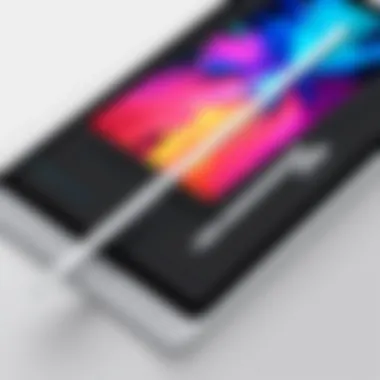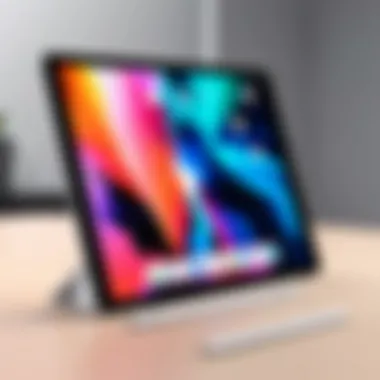In-Depth Review of Apple Pencil 2nd Generation Compatibility


Intro
The Apple Pencil 2nd Generation has become a favored tool among digital artists, students, and professionals alike. Understanding its compatibly with various devices plays a crucial role in maximizing its utility. This section provides an overview of its key features, specifications, and how these elements make the Apple Pencil a valuable addition to the user's technological setup.
Key Features
Design and Build Quality
The Apple Pencil 2nd Generation offers a sleek, minimalistic design. Its matte finish not only enhances grip but is also designed to prevent it from slipping from surfaces. The seamless and rounded edges contribute to a comfortable holding experience during lengthy sessions of writing or drawing. Importantly, its weight is well-balanced, making it easy to use for extended periods without excessive fatigue.
Display and Performance
This accessory works hand in hand with compatible iPads to deliver an unmatched experience in terms of precision and responsiveness. The low latency and high accuracy make it ideal for intricate tasks, be it designing, note-taking, or crafting digital art. Users often report that the Pencil feels more like a traditional writing instrument than a digital tool, which is a testament to its performance.
The Apple Pencil 2nd Generation transforms the iPad into a versatile tool for creativity, allowing users to interact in ways they never thought possible.
Product Specifications
Technical Specifications
The Apple Pencil 2nd Generation utilizes advanced technologies that contribute to its functionality. It features pressure sensitivity, which detects how hard the user presses down, enabling varying line thickness and shading effects. Tilt recognition also allows for varied stroke angles, mimicking traditional techniques used in drawing or sketching.
Compatibility and Connectivity
One of the most distinguishing factors of the Apple Pencil 2nd Generation is its connectivity with devices. It is exclusively compatible with the following iPad models:
- iPad Pro (11-inch)
- iPad Pro (12.9-inch) 3rd generation and later
- iPad Air (4th generation)
- iPad mini (6th generation)
The pairing process is seamless; users can simply attach the Pencil magnetically to the side of a compatible iPad to pair and recharge. This convenience reinforces its practical application, as it reduces the need for cables and complex setups.
By being aware of its specifications and compatible devices, users can ensure they make the most of this powerful tool in their digital endeavors.
Understanding the Apple Pencil 2nd Generation
Understanding the Apple Pencil 2nd Generation is vital for users seeking an optimal digital experience with their devices. The Apple Pencil is not just a stylus; it represents an evolution in the way we interact with technology. This section explores its significance by examining various elements such as its features, design changes, and technical specifications.
The Apple Pencil 2nd Generation enhances productivity for professionals, artists, and students. Its improved integration with compatible devices allows for a smoother workflow. Knowing the key aspects of its functionality can help users unlock its full potential, leading to enriched creative expressions and enhanced productivity.
Overview of Features
The Apple Pencil 2nd Generation boasts several advanced features that make it stand out as a professional tool. Notable enhancements include:
- Double-tap functionality: This feature allows users to switch between tools quickly, streamlining the creative process. For instance, artists can alternate between brush and eraser seamlessly.
- Low latency and precision: The improved responsiveness of the Pencil offers near-instant feedback on strokes, which is essential for accurate drawing and writing.
- Magnetic attach and charging: The Pencil attaches magnetically to the iPad Pro and charges wirelessly, eliminating the need for messy cables.
These features together facilitate a more intuitive user experience, making the Apple Pencil not just an accessory, but an essential part of the device it accompanies.
Design Changes
The 2nd Generation Apple Pencil introduces several design modifications compared to its predecessor. These design changes are more than just aesthetic; they enhance usability:
- Flat edges: The Pencil's flat design helps prevent it from rolling off surfaces, making it more practical for on-the-go use.
- New surface material: The redesigned surface offers a more comfortable grip during prolonged use, reducing fatigue for users.
- Color options: While still predominantly white, there are subtle nuances in finish that align with the aesthetics of newer iPad models.
These design improvements highlight Apple's focus on both form and function, leading to a device that feels integrated within its ecosystem.
Technical Specifications
Understanding the technical specifications of the Apple Pencil 2nd Generation is crucial for compatibility checks. Key specifications include:


- Battery life: The Pencil supports several hours of use on a single charge, ensuring longevity during intense creative sessions.
- Recharge time: It only takes about 15 seconds to get a significant charge, which is immensely convenient for users in a hurry.
- Pressure sensitivity: The 2nd Generation offers advanced pressure and tilt sensitivity, allowing for variation in stroke width and opacity, crucial for any professional-level artistry.
In summary, these technical specifications contribute to making the Apple Pencil 2nd Generation a valuable asset for anyone looking to enhance their digital engagement with Apple's devices.
Compatible Devices
The compatibility of the Apple Pencil 2nd Generation is a crucial factor for users wishing to integrate this tool into their digital workflow. Understanding which devices support the Apple Pencil ensures that users do not encounter unexpected limitations when attempting to use the device for drawing, note-taking, or other creative applications. The importance of compatibility extends beyond mere functionality; it significantly impacts the overall user experience and satisfaction. As technology evolves, having clarity on supported devices can save consumers time and investment in products that may not meet their needs.
Supported iPad Models
The Apple Pencil 2nd Generation is designed to work with a select range of iPad models. This includes the iPad Pro models, specifically those introduced after 2018, such as the 11-inch iPad Pro and the 12.9-inch iPad Pro. Additionally, the Apple Pencil is compatible with the iPad Air models released starting from the 4th generation. Having the right model is essential, as older models may not support all features of the Apple Pencil.
Here are the supported models:
- iPad Pro (11-inch) (1st and 2nd generation)
- iPad Pro (12.9-inch) (3rd, 4th, and 5th generation)
- iPad Air (4th generation)
- iPad Mini (6th generation)
This compatibility list not only highlights the specific devices that can work with the Apple Pencil but also emphasizes the importance of checking the version prior to purchase. It ensures that users can fully utilize the functionality offered by the 2nd generation of the Apple Pencil.
iPad Pro Compatibility
For creatives and professionals, the iPad Pro serves as a powerful platform for the Apple Pencil 2nd Generation. The iPad Pro models feature a high-resolution Liquid Retina display that enhances drawing and writing precision. The ProMotion technology incorporated into these models offers an impressive refresh rate of up to 120Hz, allowing for smoother strokes and improved responsiveness.
The compatibility is further enriched with features such as:
- Magnetic attachment: The Apple Pencil attaches magnetically to the iPad for easy carrying and charging.
- Double-tap functionality: Users can switch between tools easily by tapping the pencil, enhancing workflow significantly.
In this context, the usage of the Apple Pencil on an iPad Pro can elevate digital art and note-taking to a professional level, making it an attractive option for artists and students alike.
iPad Air and iPad Mini Support
The support for the Apple Pencil on the iPad Air and iPad Mini expands the accessibility of this stylistic tool to a broader audience. The iPad Air (4th generation) opens up another option for users who seek high performance, offering a robust experience similar to that of the iPad Pro, though at a more accessible price point.
The iPad Mini (6th generation) also supports the Apple Pencil 2nd Generation. This device combines portability and power, making it a convenient option for users who want to capture ideas on the go without sacrificing the capabilities offered by the Apple Pencil.
For users of the iPad Air and iPad Mini, the ability to use the Apple Pencil enhances the versatility of these devices. The following benefits highlight the importance:
- Improved note-taking capabilities, especially in professional and academic settings.
- The ability to create digital art without needing a larger device.
Formerly limited to just the Pro lineup, the inclusion of these models means that Apple Pencil’s innovative technology can be experienced by a wider audience, catering to various needs and preferences.
Differences with the First Generation
Understanding the differences between the Apple Pencil 2nd Generation and its predecessor is crucial for users who seek to maximize their creative potential. The advancements are significant and influence both usability and performance. Knowing these differences helps consumers make informed decisions about upgrading or adopting the Apple Pencil. Here, we will breakdown key areas: design compatibility, performance enhancements, and overall convenience.
Design and Connective Differences
The design of the Apple Pencil 2nd Generation reflects a refined approach that addresses user feedback from the first model. The new design is sleeker and more balanced.
- User-Friendly Design: The Apple Pencil 2 features a matte finish that improves grip compared to the glossy surface of the first generation. This aids in prolonged usage without discomfort.
- Magnetic Attachment: Perhaps one of the most notable changes is the introduction of magnetic attachment. This allows the pencil to snap onto the side of compatible iPads, prominently the iPad Pro models. This method of storage is secure and highly convenient.
- Double-Tap Functionality: Another critical shift includes the double-tap function that allows users to switch tools seamlessly. This feature enhances workflow efficiency for professionals.
Understand these improvements as part of a move towards a more integrated and responsive user experience.
Performance Enhancements
Examining performance differences reveals how the Apple Pencil 2nd Generation meets the evolving demands of creative work.
- Precision and Responsiveness: The newer model improves the responsiveness of input, reducing latency significantly during use. This allows artists to create with a higher level of accuracy.
- Pressure Sensitivity: The pressure sensitivity range is expanded. This means users can create varying line weights, making the pencil feel more like traditional drawing tools.
- Tilt Functionality: Additionally, the tilt sensitivity enables a natural shading technique when drawing, which was less pronounced in the first generation.


These enhancements open a new realm of possibilities for illustrators, designers, and writers, facilitating a workflow that mimics real-world writing or sketching with added digital capabilities.
Charging Methods and Convenience
The charging method of the Apple Pencil has evolved to enhance convenience immensely.
- Wire-Free Charging: The first generation required a lightning connection directly to the iPad, which lacked practicality. The Apple Pencil 2 now charges wirelessly when attached to the iPad. This change not only frees up the lightning port but also simplifies the charging process.
- Quick Charge Capability: A brief attachment to an iPad provides sufficient power for a substantial amount of usage. This minor adjustment drastically improves usage continuity, making the creative process less interrupted.
Together, these features reinforce the sentiment that the users do not merely gain a tool but an integrated part of their creative suite, one that is intuitive and powerful enough for demanding tasks.
User Experience Insights
User experience is a critical aspect when discussing the Apple Pencil 2nd Generation. It encompasses all interactions a user has with this device and how effectively it meets their needs. Understanding user experience can inform potential buyers about the functionality and performance they can expect. This is particularly relevant for creative professionals, as they rely heavily on precision and fluidity when using digital tools.
Drawing and Writing Performance
The drawing and writing performance of the Apple Pencil 2nd Generation is one of its primary selling points. Users appreciate the device's ability to offer a natural and responsive experience, closely resembling traditional pen and paper. The low latency ensures that strokes appear on the screen almost instantaneously, enhancing the overall flow of the creative process. Additionally, the smooth glide over the display reduces friction, which often leads to improved accuracy and comfort during use.
When comparing with earlier models, the second generation improves significantly in terms of accuracy. The advanced tip technology adds more precision to fine details, making it suitable for professionals in graphic design and illustration. The graphics respond well to both swift and gentle movements, allowing for flexibility in artistic expression. For those serious about their craft, this level of performance is a key advantage.
Tilt and Pressure Sensitivity
Tilt and pressure sensitivity are essential features that set the Apple Pencil 2nd Generation apart. These attributes allow the device to register varying degrees of pressure and angles, which translates into thicker or thinner lines. This functionality is invaluable for artists who wish to mimic the effects of traditional drawing tools.
With up to 4096 levels of pressure sensitivity, users can achieve a wide range of effects, from delicate shading to bold strokes. Additionally, the tilt functionality allows for more natural shading techniques, adding depth to artwork without the need for additional adjustments. This accurate representation of artistic input leads to a more immersive and intuitive user experience.
Feedback from Creative Professionals
The perspective of creative professionals sheds light on the practical applications of the Apple Pencil 2nd Generation. Many users report that it seamlessly integrates into their workflows. Graphic designers, illustrators, and animators consistently praise the precision and responsiveness of the device. They appreciate that it allows for an uninterrupted creative flow, enabling them to focus on the art rather than the tools.
Moreover, feedback emphasizes the importance of comfort during extended use. The lightweight design and ergonomic considerations make it easy for individuals to maintain a natural grip, reducing fatigue. Creative professionals find that the Apple Pencil helps them generate ideas more effectively. This positive reception from the creative community adds to the device's reputation and builds confidence for prospective users.
"The Apple Pencil feels right at home in my hand. It’s like an extension of my thoughts." – A Professional Illustrator
Technical Requirements for Use
Understanding the technical requirements for the Apple Pencil 2nd Generation is essential for users aiming to maximize its functionalities. These requirements set the foundation for achieving optimal performance and seamless integration with supported devices. Without grappling with the specifications and compatibility aspects, users may find themselves unable to utilize the full capabilities of this accessory, leading to frustration and underutilization.
Software Compatibility
The Apple Pencil 2nd Generation operates in tandem with a variety of software applications that support stylus input. This compatibility is crucial, as the effectiveness of the Pencil relies on the software optimizing its features.
Creative applications like Procreate and Notability scale well with the Pencil, enhancing the drawing, sketching, or note-taking experience. These apps leverage the Pencil's sensitivity to pressure and tilt. However, not all applications support these features equally, which makes it vital for users to check if their favorite apps are compatible with the Apple Pencil. Moreover, the integration of the Pencil with iPadOS provides enhancements in multitasking and productivity that illustrate the importance of both the device and software working in harmony.
iOS Version Requirements
Users must also consider the specific iOS version requirements when seeking to utilize the Apple Pencil 2nd Generation. The device operates optimally on iPadOS 14 or later. Running older versions might limit functionality, which can impact user experience significantly.
To check the iOS version on an iPad, users can navigate to Settings > General > About. Ensuring that the iPad is updated to the latest software version not only unlocks new features but also provides essential security updates that safeguard devices from vulnerabilities. By keeping the device's software current, users can ensure compatibility with new applications and features that emerge within the Apple ecosystem.
"Understanding the foundational aspects of software and iOS version compatibility is key to unleashing the full potential of the Apple Pencil 2nd Generation."
As a final note, paying attention to technical requirements can save users time and effort in troubleshooting. It helps in avoiding practical hurdles before they arise, making for a more productive and enjoyable experience.
Limitations and Challenges
Understanding the limitations and challenges of the Apple Pencil 2nd Generation is crucial for potential users. While this accessory offers a range of impressive features and compatibility, acknowledging its boundaries allows for informed decision-making. These limitations can affect usability, performance, and overall satisfaction with the product. Addressing these aspects means users might avoid frustrations and utilize the Apple Pencil's full capabilities more efficiently.


Device Limitations
The Apple Pencil 2nd Generation is specifically designed to work with certain devices. This means that not every iPad model is compatible. The range of supported devices includes recent models like the iPad Pro and the iPad Air. However, older iPad models do not support this Apple Pencil.
This limitation can be a significant disadvantage for users who own older iPads. They may find themselves unable to leverage the advanced features of the Apple Pencil, such as pressure sensitivity and tilt functionality.
Potential buyers should be aware of these limitations:
- Compatibility Range: Only select iPad models support the Apple Pencil 2nd Generation. Ensure your device is listed among these.
- Upgrading Requirements: If a user wishes to use the Apple Pencil, upgrading their iPad may be necessary.
Users must carefully consider whether their current device meets the requirements before purchasing the Apple Pencil. For some, it might mean additional investment in the latest technology.
Common Connectivity Issues
Connectivity issues can also be a frustrating challenge for Apple Pencil 2nd Generation users. Although the pairing process is generally straightforward, there are times when connection problems may arise.
Common connectivity issues include the following:
- Unresponsive Pencil: Sometimes, the Apple Pencil does not respond to touch. This can lead to confusion, especially when trying to draw or write.
- Disconnection from iPad: There are instances when the Apple Pencil disconnects unexpectedly. Re-pairing can be necessary, which interrupts the workflow.
Troubleshooting these issues often involves simple steps, such as:
- Removing and re-attaching the Pencil to the iPad.
- Restarting both the Apple Pencil and iPad.
- Ensuring that the iPad's Bluetooth is turned on.
Addressing these common problems is vital for ensuring a smooth user experience. Understanding these limitations means users can better prepare themselves for potential challenges.
Future of Apple Pencil Technology
The future of Apple Pencil technology is a critical topic for users and tech enthusiasts alike. Understanding potential upgrades and product integrations can significantly influence purchasing decisions and usage strategies. The Apple Pencil 2nd Generation already presents a high level of sophistication, but advancements in technology often follow exponential growth patterns. Anticipating future developments is essential for maximizing the utility of the Apple Pencil within an expanding ecosystem of devices.
Predicted Upgrades
Apple is known for its commitment to innovation. Predicted upgrades for the Apple Pencil may revolve around enhanced functionality and improved user experience. Key areas for potential upgrades include extended battery life, more responsive tip technology, and incorporation of new features such as haptic feedback. These enhancements could provide users a more immersive experience when drawing or writing.
Moreover, software improvements might be on the horizon. Integration with more advanced creative applications could allow for finer control and customize settings based on user preferences. Here are several predicted upgrades for Apple Pencil:
- Battery life enhancement: A longer-lasting battery might reduce the frequency of charging.
- Improved pressure sensitivity: More gradient levels could help artists better express their creativity.
- Haptic feedback technology: This could simulate the feeling of different drawing surfaces, enriching the user experience.
Integration with Future Devices
As technology transitions, integrating Apple Pencil with newer devices creates opportunities for broader functionality. This integration is particularly relevant as Apple continues to expand its product lineup, including developments in iPads, Macs, and potentially other devices like AR glasses.
The Apple Pencil should ideally be designed to work seamlessly across a variety of platforms, such as:
- Augmented Reality (AR): Future devices may leverage the Apple Pencil for interactive AR applications, allowing users to create and manipulate digital content in a real-world environment.
- Mac Computers: A strong possibility exists for the Apple Pencil to work with Mac devices, targeting users who prefer precise input methods for graphic design.
- New iPad Models: Upcoming iPad releases could feature enhanced compatibility to allow for advanced functionality only achievable through new technologies.
Finale and Recommendations
In wrapping up, it is significant to recognize the importance of evaluating the compatibility of the Apple Pencil 2nd Generation. Understanding which devices support this accessory, along with its strengths and limitations, can enhance user experience immensely. Consumers can make informed choices about their purchases and how to maximize their potential with the Pencil.
To summarize, the Apple Pencil 2nd Generation offers improved design and performance over prior models. It is compatible only with certain iPads, which can limit its usability for some users. This specificity makes it paramount to cross-reference device specifications before acquiring the Pencil. For instance, not all iPads can utilize the advanced features, such as tilt and pressure sensitivity, which some creative professionals rely upon.
Below are key points for consideration:
Summary of Key Points
- Supported Devices: The Apple Pencil 2nd Generation is compatible with various iPad models such as the iPad Pro (11-inch and 12.9-inch 3rd generation or later), iPad Air (4th generation), and iPad Mini (6th generation).
- Technical Improvements: Enhanced pressure sensitivity and a double-tap feature for tool switching make the Pencil more versatile than its predecessor.
- Performance Expectations: Users seeking precision in their drawing or note-taking will benefit from the advanced functionalities the Apple Pencil offers.
- Limitations: Users must be aware of the specific iOS requirements and potential connectivity challenges that can arise.
Best Practices for Users
- Check Device Compatibility: Always verify if your iPad is supported before purchasing the Apple Pencil 2nd Generation. This may save time and money in the long run.
- Update iOS: Ensure your device runs the latest iOS version, as some features may depend on specific updates for performance enhancements.
- Utilize the Right Software: Employ applications that harness the full capabilities of the Pencil, like Procreate or Notability. This can considerably elevate the user experience.
- Care for the Pencil: Although designed for longevity, handle the device with care. Clean the tip regularly and store it properly to avoid damage.
"Compatibility is crucial for maximizing any device's efficacy. The Apple Pencil 2nd Generation is no exception."
By following these recommendations, users can navigate the landscape of the Apple Pencil 2nd Generation effectively and enjoy the creative potentials it unlocks.



